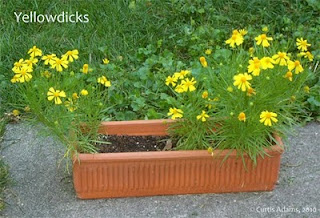Here are some of the plants that I am growing this year. Lantana, Lantana camara, is technically a North American native, since its native range includes Mexico and Puerto Rico. It behaves well as a bedding or potted plant in colder climates, but it is invasive in the warmer parts of the US, particularly Florida and Texas. I really love the red-orange-yellow multi-colored flowers and long blooming period. These I bought from a nursery and mixed in with other classic annuals like the Lobelia, shown here. The rest of the annuals I have grown from seed.
While on a trip to Austin, TX, I picked up seeds for Drummond phlox, Phlox drummondii, and the annual Indian Blanket, Gaillardia pulchella, at the Lady Bird Johnson Wildflower Center. These appeared to be species plants and not any crazy cultivars. So far the Phlox has made it to bloom, with its scarlet red flower. The Indian blanket is just a week or so away. Another Texas native I have growing in pots and in the ground is Scarlet Sage, Salvia coccinea. None of these plants really started growing until the temps here got well into the 80’s.
I was really happy to see that some seed from the Beach Sunflower, Helianthus debilis ‘Pan’, that I grew last year had germinated in the same pot. Native to the Texas coast, this species has spread up the East Coast all the way to Maine. Here it is in bloom last year in the same pot. I have also grown Bearded Beggarticks (Bidens aristosa) in pots. Given half a chance, this eastern native reseeds itself readily.
Some native annuals that I had in pots last year are Devil’s Claw (Proboscidea louisianica), Yellowdicks (Helenium amarum ‘Dakota Gold’), and Bird’s Eye Gilia (Gilia tricolor).
 The native perennial that I have in a pot is the Crimson-eyed Rosemallow, Hibiscus moscheutos, that I bought from the New England Wildflower Society. While it is native to New England, I just don’t have the sunny moist site it would like to keep it in. I over-wintered this in its pot by storing in a plastic bag with salt marsh hay in an unheated garage. It looks pretty happy so far. The blooms are expected in late summer.
The native perennial that I have in a pot is the Crimson-eyed Rosemallow, Hibiscus moscheutos, that I bought from the New England Wildflower Society. While it is native to New England, I just don’t have the sunny moist site it would like to keep it in. I over-wintered this in its pot by storing in a plastic bag with salt marsh hay in an unheated garage. It looks pretty happy so far. The blooms are expected in late summer. 
















